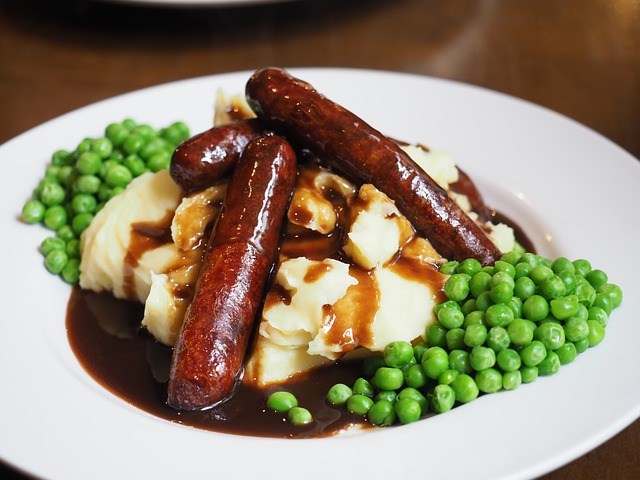Gravy is such a well-known and often-used part of a meal in the United States and Europe – so much so, it can be easily overlooked.
It’s so ubiquitous that gravy is even a part of our language. The phrase “riding the gravy train” is a slang term for when a person receives money without having to put out much effort.
It’s also in a much less happy phrase; if someone says that they are going to “dish out the gravy,” they mean that they are going to deliver a harsh punishment, like a prison sentence!
But you know very well that gravy is a net improvement on any meal, whether it’s just for you or as a part of a fancy meal for your friends and family.
Do you want to know how to make gravy? Here’s everything you need to get started!
Contents
What is Gravy?
Gravy is a savory sauce, and a common feature of dinner tables all over the world, both in decadent feasts and everyday household meals!
The sauce is made from meat juices left over in the pan after roasting or frying meat.
Typically, the excess fat from the cooking process is removed from the juice, and then a liquid stock or wine is added to fill out the gravy in a process known as “deglazing.”
Sometimes flour is mixed into the sauce for a thicker, more filling gravy. Gravy is commonly served alongside meat meals, such as meatloaf or roasts, or with starches such as rice and mashed potatoes.
Let’s learn a little more about the origins of gravy!
History and Origins
The word “gravy” most likely came from an Old French word, “grané,” which means “spice.” Over time, likely because of misreadings or misspellings, the word “grané” turned into the Middle English word “gravé.”
Gravé, in medieval cookbooks, referred to a spicy sauce made from ale, wine, broth, or spices. Eventually, around the sixteenth century, the term gravé began to specifically refer to a sauce made from the drippings left over from cooking meat.
In the 1950s, when everyone in the food processing industry was so focused on convenience in cooking, many innovators did their best to create simple gravy mixes that would eliminate the need for actually cooking and collecting drippings from beef or chicken.
But the results, though cheap and still used in many kitchens today, were never as delicious or satisfying as making your own gravy from scratch!
In the United Kingdom and Ireland, gravy is commonly served with a Sunday roast, or with other meats such as pork, beef, chicken, or lamb. Gravy may be eaten with just chips in this part of the world, as well.
All over the United States, Americans usually eat gravy as a part of the Thanksgiving dinner feast, accompanying their turkey, stuffing, and mashed potatoes.
In the Southern United States, people enjoy sausage gravy with their breakfast biscuits and white gravy with their chicken fried steak.
The Cajun and Creole cooks in Louisiana serve gravy with rice. Further to the north, in Canada, chefs include gravy as a part of their traditional poutine dish.
Other parts of the world use the word “gravy” to refer to slightly different foods, such as in India where the liquid part of a thick curry may be referred to as a gravy.
Italian-Americans use the word “gravy” to refer to a tomato sauce rather than the meat drippings that other Americans think of when they hear the word.
Gravy vs. Jus vs. Sauce
So if different people use the word “gravy” to refer to things that you may not think of as gravy, what actually is the difference between gravy and other liquids that we eat foods with, such as sauce and jus?
The difference between gravy and sauce is in where the liquid came from and what its purpose is to the meal.
Gravy is made from the juices of some kind of meat or other solid food, and its purpose is to extend the flavor of the meat to other parts of the meal, like mashed potatoes.
A sauce is a relish made from liquid or almost-liquid foods, and its purpose is to make other foods taste, smell, and even look better than they would normally. A sauce may be put on meat, but the sauce is not made from the meat.
Jus, pronounced “zhoo,” is very similar to gravy. As such, it comes from the drippings of cooked meat. However, while gravy is thickened with flour or some other kind of starch, jus is not.
Jus is reduced until it is a very thin liquid, and then sandwiches are dipped in it.

Making Gravy Different Types of Ways
There are many different kinds of gravy, from the typical brown gravy served with roasted meat, to the creamy gravy served with biscuits.
Other gravies are made from egg, giblets, mushrooms, onion, ham drippings, or vegetables. Some restaurants in the southern United States even serve a variety of gravy made with cocoa powder and sugar – chocolate gravy!
Making gravy varies as a process, depending on what type of gravy you are trying to make. Here is what’s entailed with several common types of gravy.
How to Make Brown Gravy
Brown gravy is the kind you’ll most often see, usually made from beef and put on all kinds of side dishes, such as rice, potatoes, and yams. Here is a recipe and method for how to make brown gravy.
Right after you remove the beef or other meat you were cooking from its pan, drain out the drippings, keeping two tablespoons left behind for the gravy in the pan.
Sprinkle two tablespoons of all-purpose flour over the drippings, and stir the flour and drippings together while cooking the mixture over medium heat.
Stir and cook until the mixture turns brown. Then gradually stir in one cup of milk, making sure that you scrape up all of the leftover bits of meat from the pan as you do so.
Then whisk in one cup of water. Increase the heat to a medium-high setting, and continue to stir and cook the gravy until it thickens. This should take about ten minutes.
Season to taste with salt and pepper when you are finished.
This video shows an example of a recipe using a brown onion gravy.
How to Make Turkey Gravy
Turkey gravy is made from turkey giblets rather than drippings and is an excellent addition to any Thanksgiving feast, naturally prepared alongside the Thanksgiving turkey.
If you want to know how to make turkey gravy, follow these simple steps.
First, place the turkey giblets into a saucepan, covering them with about two pints of water. Add one bay leaf, one sprig of thyme, four black peppercorns, and one half of a sliced onion to the pan.
Bring the water to the boil, and skim off any build-up at the top of the water. Then let the pan simmer for forty-five minutes.
Strain the stock you’ve made, and mix it with the pan juices from your Thanksgiving turkey, along with two tablespoons of plain flour.
Cook it together over a gentle heat until it turns golden brown and has a smooth texture, stirring to remove any lumps while it thickens.
How to Make White Gravy
White gravy is usually eaten with chicken fried steaks and skips the step of including meat altogether.
Do you want to know how to make white gravy? Here is a recipe that is easy to follow!
First, take a medium saucepan and melt four tablespoons of butter in it. While continuously whisking, add four tablespoons of flour, two teaspoons of fresh cracked ground pepper, one teaspoon of salt, and half a teaspoon of garlic salt.

Then, slowly pour in two and a half cups of milk, turning the heat down to a medium setting while you do so.
Let the gravy thicken for about five minutes, and then remove it from the heat. This gravy is ready for you to serve it up!
How to Make Gravy for Biscuits
All across the United States, but especially in the American South, people love to sit down to a breakfast of biscuits and gravy.
This is a tradition that dates back to the earliest European settlers in the United States, who brought this delicious classic breakfast with them from England to Jamestown, Virginia, all the way back in the 1600s!
The kind of gravy eaten with biscuits is most commonly a creamy sausage gravy. Here is how to make sausage gravy perfectly for your breakfast table.
First, cook crumbled-up sausage in a large skillet over medium heat until it is fully heated. This should take between five and six minutes, with frequent stirring while you heat the sausage.
Stir in 1/4 cup of flour, and then gradually add two and a half cups of milk to the mixture. While continuing to stir, cook the mixture until it comes to a boil and thickens.
Then reduce the heat and let the gravy simmer for two minutes. Finally, season the gravy to taste with salt and pepper.
Bake some biscuits while you make the gravy, and you will be all set for breakfast!
Here’s an example of a biscuits and gravy recipe using sausage gravy.
Tips for Making the Best Gravy
There are as many ways to make gravy as there are chefs – but of course, some methods create a tastier, more satisfying product than others!
Making gravy with flour is essential. While some chefs will swear by the method of deglazing the tin with some stock or alcohol instead of using flour, this method is a lot more complicated, requiring extra prep work and an additional pan to prepare the added liquid.
Also, it does not thicken the gravy nearly as much as just mixing in flour. Sometimes simple is best!
Some home chefs and fancy restaurants use wine in their gravy, because it gives the finished product an alluring sense of sophistication – kids drink milk and grown-ups drink alcohol, right?
However, the taste of a wine can overwhelm the other flavors in a gravy, turning it into something closer to a wine sauce than the actual, traditional gravy flavor it is supposed to have.
It is much better to skip the wine and, again, stick to the simple ingredients that work best!
Also, some cooks decide to mix up their gravy by adding vegetables. They put the vegetables under the meat while it cooks, and then afterwards mash the vegetables up with the flour and meat juices to form the gravy.
This addition is appealing for the extra healthiness that including vegetables in any meal tends to supply. However, it can be difficult to mash up vegetables in a hot pan, and the result is often a mushy vegetable flavor and texture that is just not as satisfying as the normal gravy.
Some onions or roasted garlic can add a nice, innovative touch of flavor to gravy, but too much vegetable content can ruin the texture overall.
While some gravy recipes will call for a pre-made stock, such as beef stock, these often have an overpowering amount of salt in them, which ends up being the only flavor left behind when the stock is reduced into a gravy.

If you have the means, make your own stock, either from the meat that you are cooking as well for the meal or by buying and roasting a bag of beef bones. This way you can add as much or as little salt as you please, adding other flavors that you desire, such as garlic, tomato, onion, celery, carrot, or leek.
Put the bones and the vegetables together in a hot oven for an hour, and then boil it all in a large stockpot.
Let the pot simmer for five hours and you will have a rich brown stock, great to be used right then or able to be kept frozen for later!
All you have to do now is decide what kind of gravy you are craving, and get to work making it! Brown, white, or something in between?
What’s your favorite recipe for making gravy?






